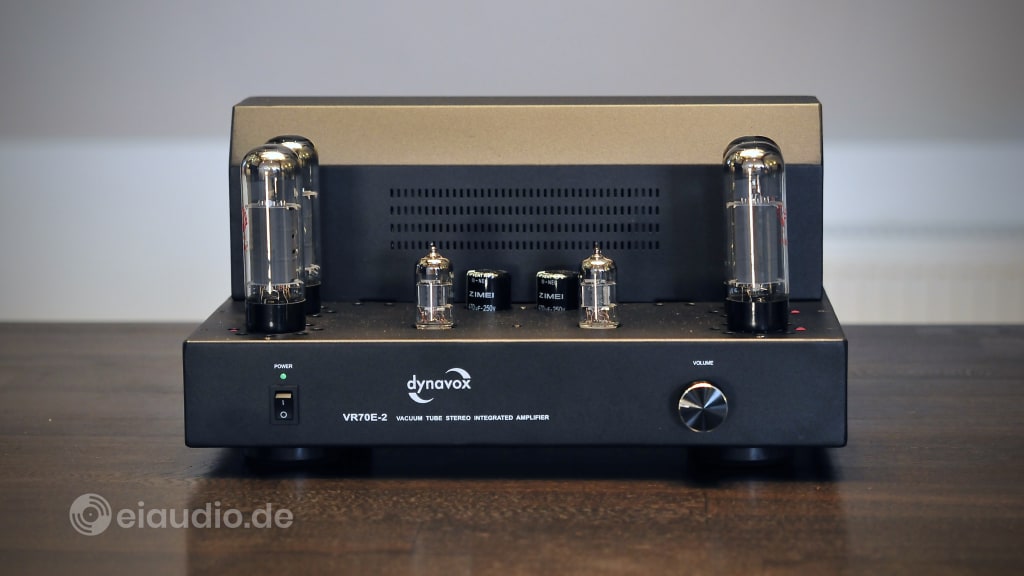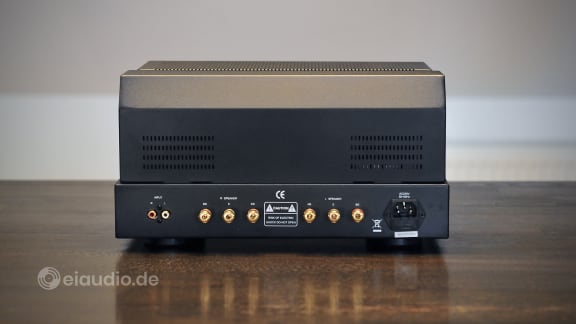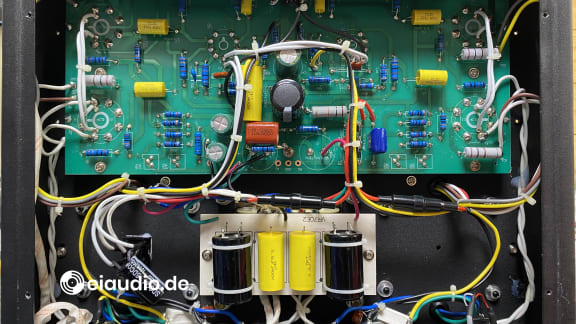Dynavox VR-70E II
Published: 03/01/2022
Manufacturing date: 2013
Author: Karsten Hein
Category: Gear & Review
Tag(s): Power Amplifiers
Dynavox is the brand name of Sintron Distribution, an importer of audio goods operating out of Iffezheim, just south of Karlsruhe in Germany. This is not to be confused with DynaVox, a manufacturer and distributor of speech-generating devices from Pittsburg, Pennsylvania. The Dynavox brand name first appeared on audio devices during the mid-90s, a time when more sophisticated audio products were becoming available from Asia, often for a fraction of the price of similar products from European or American manufacturers. With China and other Asian countries gradually opening their economies to invite private entrepreneurs, they also increased private wealth and brought about a local hunger for genuine high fidelity products, such as tube amplifiers.
To the western audiophile community, Dynavox is also a reference in name to the famous Dynaco audio brand founded by David Hafler. Similar to Mr Hafler, the importers of Dynavox products believed that genuine Hi-Fi engineering should be made available to the general public, rather than a select few. The name of the Dynavox VR-70 tube amplifier itself is reminiscent of the legendary Dynaco ST-70 tube amp. However, while modern renditions of the Dynaco sell for 2,000 - 3,000 EUR — far removed from Hafler’s dream of making Hi-Fi affordable — the Dynavox VR-70 hit the German market at just under 300.00 EUR. And, while the original VR-70 was clearly not in the same league as the revised Hafler tube amps of today, it did have a huge price advantage over its competition, offering about 90% of the listening pleasure. A warning shot to the established western audio royalty.
Its low entry price made the small VR-70 tube amplifier the entry ticket to audiophile listening for many starters to the genre in Europe. With more units being sold of this and other products, Sintron Distribution turned from importer to designer, in the sense of being able to influence the design process, based on the feedback they received from their customers either directly, or, more recently, through web-forums. To keep product prices down, Dynavox continued to keep their audio designs in simple boxes, apparently making concessions in exterior design rather than sound. With the continuous improvement of their products and growing general acceptance by the audio community, demand finally did begin to affect prices and customer expectations. Today’s VR-70 models sell at double the price of their early arrivals and are possible better engineered, rooting out some of the very early issues.
Dynavox, today, designs and imports tube preamplifiers, stereo tube amplifiers, and mono block tube amps, the PS-320 BT turntable, an assortment of cables and accessories, as well as noise-filtering power distributors. After 20 years on the German market, the company portfolio is still relatively limited, but the products are meanwhile well-established and have a reputation of offering value for money. While I am typing this text, I am listening to a Dynavox VR-70 E II stereo tube amplifier playing Jazz in its simple and inexpensive black powder coated cabinet. It has a reassuring red LED power indicator on the left and a not quite so reassuring volume knob on the right of its front panel. The tubes are barely visible through the grid enclosure. Only when I get closer, I can see them glowing and feel their heat radiating towards me.
I had bought the Dynavox VR-70 E II from a store called VinylNerds.de, and I had done so actually not for myself, but on behalf of my colleague from work, who had been looking for an affordable amplifier to power his speakers. I saw him looking at imports directly from Asia and suggested he might try the VR-70 with added the benefit of purchasing from a local distributor and shop. He agreed that this was a good idea, but some days later (as these things go) was reminded by his wife that there were currently more pressing issues for the family than Hi-Fi. This was understandable, of course, but I was still happy to have the opportunity of listening to the VR-70 E II. To be honest, I am meanwhile probing into the possibility of keeping it for myself. This is not a bad-sounding amp at all, even after having listened to some legendary names in the industry.
The Dynavox VR-70 E II weighs close to 15 kg and arrived here well-protected in a large and heavy triple-packaged cardboard box that was filled with thick foam interior profiles. All tubes and the protective cage were pre-installed. I saw that the left side of the grid cage protecting the tubes was unevenly painted, but since the amp was all-black and a full-metal design, this minor flaw in the paint coat was only visible if one took a very close look. Other than this, I was positively surprised that it measured only 35 cm in width and looked solid and clean. Since I had originally not intended to keep this amp for myself, I had not given its design and size much thought. But having spent some years in Hi-Fi, I have come to enjoy such deviations from the standard rack format. I loosened the screws of the cage to inspect the tubes and saw that they all had survived the journey to our house in one piece.
I had read somewhere that bias should be adjusted to 300-350mV for good result, but I could not remember if this was with the tubes being at full operating temperature. So, I decided to give the amp a listen with the factory settings in place. I gave our Hafler XL280 amplifier a final discerning listen, playing Diana Krall’s album “Turn up the quiet”, and then changed to the VR-70 E II amp. I left the room for four hours straight, while it was warming up from the trip. When I returned, I noticed that the music was less spacious than with our Hafler. Diana’s voice had a slight edge and graininess to it that made it less believable and more sibilant. Bass, too, was a little weak and compressed in direct comparison. The VR-70 also better transported the slight tube hissing coming from our Dynaco PAS-4 preamp or added some on its own. Given that the VR-70 E II is a 40 watts per channel beast (as far as tube power is concerned) that is perfectly capable of heating a room, I was a little disappointed by the flatness of its sound. The amp was not as engaging as I was used to. However, there was also a mild sense of fulfilment, because what I was hearing was not completely wrong either.
Our Hafler XL280 is a very good amp that has had plenty of time to run it. The Dynavox had just come in from the cold and was perhaps playing music for the first time. I understood that the factory tubes used on the pre and amp section had been chosen for their bang-for-buck performance rather than their audiophile virtues. The same was probably true for some of the components inside the amp. If my present listening experience was really all that could be expected from this amp, I would need to send it back; but, with the potential for more, I was willing to give it some time and thought. My first step was to make an appointment with our specialist for tube amp designs to discuss the merits of the amp's basic layout and components. I also began to search the net for opinions on upgrading it to audiophile level.
When I arrived at our tube amp specialist, I was curious to see what would await us under the hood. While the stock tubes seemed to be of decent Chinese quality, we were met by a worn-out screw on the amp's underbelly which we had to pry loose using pliers. It seemed that the white bottom plate was without proper electrical contact to the chassis, a circumstance that could be improved. Once inside, we also noticed that the legs of one capacitor had been twisted during assembly and nearly touched, a flaw that we quickly corrected. The parts on the inside appeared to be of decent quality for audio devices at this price point, and yet, there was clear potential for improvement by replacing them with more capable components. I suggested that the general layout of this little amp seemed well thought out, and the tube specialist agreed that there was potential in this design. He said he would gladly assist me in making this an audiophile amp. We agreed to first focus on the refitting of the interior parts and to then listen to the results for a while, before ultimately deciding on which tubes to change to.
Note for non-EU citizens: The type VR-70 E tube amplifier is also sold through the “Affordable Valve Company” in Britain, under the brand of ‘Audio Institute’. To my knowledge it is essentially the same amplifier that has been optimised for the British market.
Mod suggestions
- removing the input caps and bypassing the volume control
- upgrading the power supply caps and rectifier diodes to Wolfspeed Z-Rec 1.2 kV, 10 A, 11 nC
- upgrading the 70 V circuit by adding Mundorf MCaps Supreme 0.1uF 1400V
- replacing the negative feedback caps (C5 on PCB) with Charcroft Audio Silver Mica 47pF 500V
- adding a switch and circuit to change between ultra-linear and triode mode
Specifications
- Power output (RMS, 8 ohms): 2 x 40 watts
- Input impedance: 20 kOhm
- Pre-amplifier tubes: 2 x 6F2 (ECF82)
- Power amplifier tubes: 4 x EL34 (ultra-linear)
- Tube bias: 300 - 350 mV
- Frequency response: 10 - 40,000 Hz
- Total harmonic distortion: 0,1%
- Signal to noise ratio: >88 dB
- Damping factor: N.N.
- Output terminals: 4/8 Ohm, gold plated, for spades or bananas
- Dimensions: (W) 35,0 cm x (D) 30,0 cm x (H) 18,5 cm
- Weight: 14,5 Kg
- Year: 2013 -






